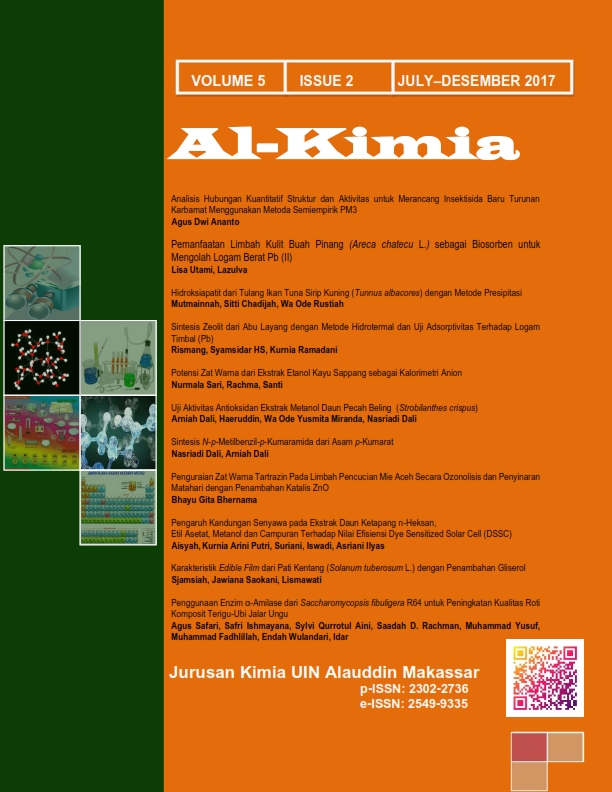Pengaruh Kandungan Senyawa pada Ekstrak Daun Ketapang n-Heksan, Etil Asetat, Metanol dan Campuran Terhadap Nilai Efisiensi Dye Sensitized Solar Cell (DSSC)
Abstract
The needs of electrical energy that increase year by year cause electrical energy crisis. Alternative energy sources which are potential to be developed as a substitute of fossil fuels are organic solar cells or DSSC (Dye Sensitized Solar Cell). The purpose of this study is to determine the value of efficiency resulting from Ketapang leaf extract and to determine the effect of compound content in Ketapang leaf extract toward the value of DSSC efficiency. This study investigate the efficiency value of the DSSC which are senzitized by the N-hexane, ethyl acetate, methanol extract of the Ketapang leaf and the mixture extract. The compounds from each axtract are characterized used UV-Vis and FTIR. The measurement results of the efficiency value from n-hexane of Ketapang leaf extract, ethyl acetate, methanol and the mixture were respectively 0.0051%, 0.09%, 0.12% and 0.22%. The results of UV-Vis characterization with maximum wavelength were respectively 667 nm, 665.9 nm, 665.9 nm and 209 nm. The FTIR identified an auxchrome group such as -OH, C-N, -NH, and C-O as well as chromophore groups such as C=O and C=C. These data support that the existence of flavonoid and alcaloid compound in the mixture extract generate significant efficiency value.
Downloads
References
Baharuddin, A, Aisyah, Saokani, J., & Risnah, I.A. (2015). Karakterisasi Zat Warna Daun Jati (Tectona grandis) Fraksi Metanol:N-Heksana Sebagai Photosensitizer pada Dye Sensitized Solar Cell. Chimica et Natura Acta, 3(1), 37- 41.
Damayanti, R., Hardeli & Sanjaya, H. (2014). Preparasi Dye Sensitized Solar Cell (DSSC) Menggunakan Ekstrak Antosianin Ubi Jalar Ungu (Ipomoea batatas L.). Jurnal Saintek, 6(2), 148-157.
Ekasari, V & Yudhoyono, G. (2013). Fabrikasi DSSC dengan Ekstrak Jahe Merah (Zingiber offocinale Linn Var. Rubrum) Variasi Larutan TiO2 Nanopartikel Berfase Anatase dengan Teknik Pelapisan Spin Coating, Jurnal Sains dan Seni 2(1), 2337-3520.
Harbone, J.B. 1987. Metode Fitokimia Penuntun Cara Modern Menganalisis Tumbuhan. Bandung: ITB Bandung.
Latif, M. & S. Abdel, dkk,. (2013). Plant Seeds-Based Dye-Sensitized Solar Cell. Materials Sciences and Applications, 4(4), 516-520.
Lee, S.F., Chang, Y.P., Lee, L.Y. & Hsu, J.F. (2007). Characterization of Dye Sensitized Solar Cell with ZnO Nanorod, Journal Engineering Technology and Education, 9(5), 545- 552.
Maddu, A., Zuhri, M, & Irmansyah (2007). Penggunaan ekstrak antosianin kol merah sebagai fotosensitizer pada sel surya TiO2 nanokristal tersensitisasi dye. Jurnal Teknologi ,11(2), 78-84.
Maming, M. S., Aisyah, Suriani & Iswadi, (2017). Photosenzitizer dari Fraksi Metanol: N-Heksan Buah Cabe Merah (Capsicum annum L.). Al-Kimia, 5(1), 31-38.
Mathew, S., Yella, A., Gao, P., Humphry-Baker, R., Basile F. E. Curchod, Ashari-Astani, N., Tavernelli, I., Rothlisberger, U., Nazeeruddin, M.K,... Gra¨tzel, M. (2014). Dye-Sensitized Solar Cells with 13% Efficiency Achieved Through the Molecular Engineering of Porphyrin Sensitizers. Nature Chemistry, 6(3), 242-247.
Subandi & Handi, S. (2015). Pembangkit Listrik Energi Matahari Sebagai Penggerak Pompa Air dengan Menggunakan Solar Cell. Jurnal Teknologi Technoscientia ,7(2), 157-163.
Copyright (c) 2017 Aisyah Aisyah, Kurnia Arini Putri, Suriani Suriani, Iswadi Iswadi

This work is licensed under a Creative Commons Attribution-NonCommercial-ShareAlike 4.0 International License.
Authors who publish with this journal agree to the following terms:
1) Authors retain copyright and grant the journal right of first publication with the work simultaneously licensed under a Creative Commons Attribution License that allows others to share the work with an acknowledgement of the work's authorship and initial publication in this journal.
2) Authors are able to enter into separate, additional contractual arrangements for the non-exclusive distribution of the journal's published version of the work (e.g., post it to an institutional repository or publish it in a book), with an acknowledgement of its initial publication in this journal.
3)Authors are permitted and encouraged to post their work online (e.g., in institutional repositories or on their website) prior to and during the submission process, as it can lead to productive exchanges, as well as earlier and greater citation of published work (See The Effect of Open Access).


